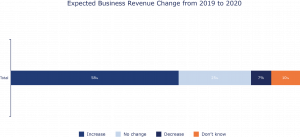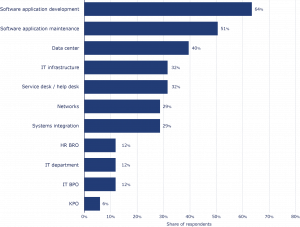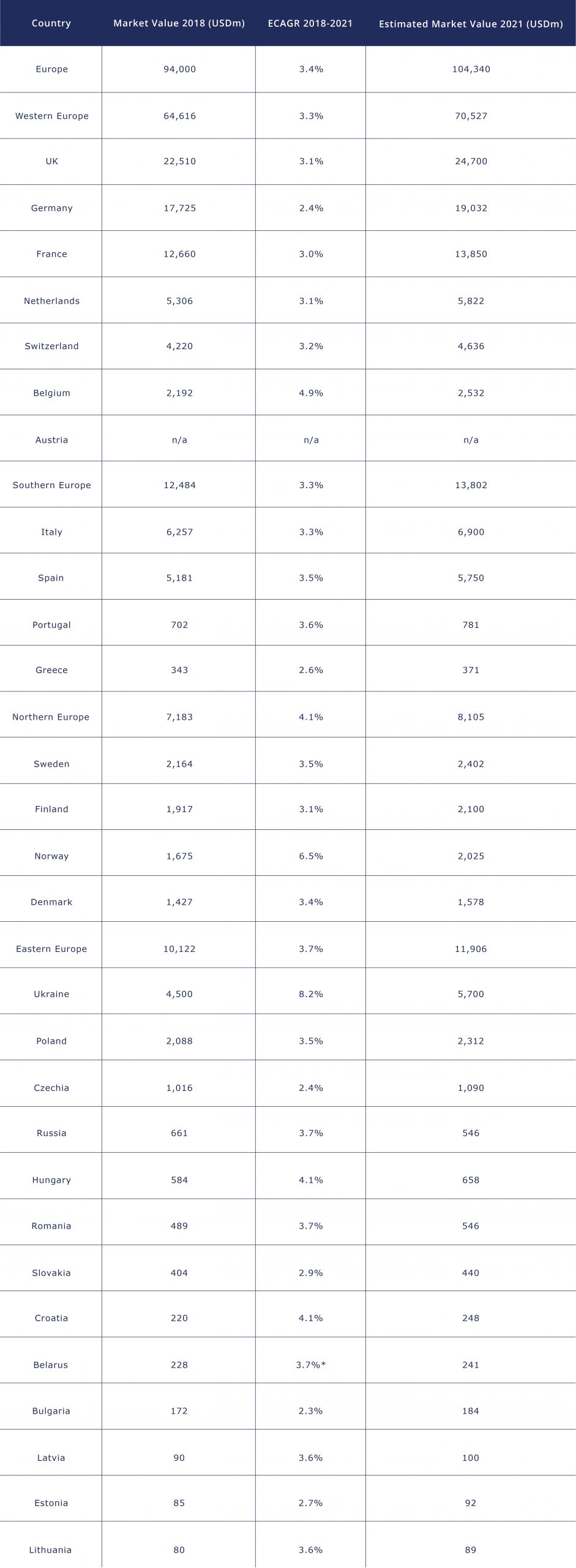IT outsourcing is a B2B relationship between an IT outsourcing company and client organisation where the former provides the latter with the IT specialists to fulfil a technology staffing need. As a professional service, IT outsourcing can be packaged in a variety of different ways. But they all boil down to specialists employed by the provider taking on IT functions required by the client organisation.
The IT outsourcer provides, and usually directly employs, IT specialists they offer as service. IT outsourcing can be alternatively referred to as IT services. Companies that refer to themselves as IT services providers can have more of an emphasis on creating and maintaining IT infrastructure, and IT outsourcers software development, testing and maintenance, but the two terms are generally used interchangeably.
The client organisation most often pays an IT outsourcing provider for the time of specialists to a ‘time-material’ model, which usually means by the hour or day. It’s the business model that typically makes the most sense in the context of the dominant Agile methodology used by most modern IT projects. But sometimes a fixed price for a specific deliverable, such as a website, app or designing and building needed IT infrastructure is also agreed upon.
This report focuses on why and how IT outsourcing, approached correctly, can perform a key role in an organisation’s efforts to gain a competitive advantage. You’ll also gain practical insight on how to approach outsourcing in a way that makes the most of it and what to expect or demand from an IT outsourcing partner.
Common IT Outsourcing Services
The most common services offered by IT outsourcing companies are:
Software development including web development, native development, cloud-native and mobile app development.
Dedicated teams including project management to deliver client IT projects end-to-end.
Team extensions or augmentation, where one or more IT specialists are added to an existing in-house team.
IT consulting, troubleshooting or training designed to solve a particular issue the client organisation is struggling with.
Quality assurance and software testing – both manual and automated as part of a DevOps architecture.
IT infrastructure design and set up – private cloud, public cloud and hybrid infrastructures.
The Strategic Role Of IT Outsourcing For Digitally-Progressive Organisations
Today, digital transformation is a top priority for nearly every executive. Organisations understand their ability to remain competitive in the fast-moving technology landscape is heavily dependent on their ability to effectively and creatively apply IT in a way that gives them an edge over competitors.
But even the largest technology-first organisations are unable to internally resource the huge and shifting range of tech competencies fully leveraging the potential of cloud computing involves. That’s seen IT outsourcing return to favour but in a more sophisticated, integrated form. It’s no longer only about the technical execution of functional software and IT systems – almost a utility, as in the past. New motivations to leverage outsourced technical specialists include business growth, customer experience and disrupting traditional business models.
That’s created a new kind of outsourcing relationship that is far more strategic than was typical in previous times. The most successful digitally progressive organisations have developed awareness around what IT functions should be outsourced.
Cloud migration of legacy software, systems and infrastructure is a perfect example and a process almost every organisation now faces. Decision-makers have learned from early mistakes that the “lift and shift” approach to migration fails to fully leverage the value of the cloud.
Cloud specialists with experience across multiple projects are best placed to determine which applications or even functionalities within applications, are best managed in-house and which would benefit from being moved to a cloud infrastructure. And what kind of cloud infrastructure.
Strategically outsourcing parts of the cloud migration process means organisations can leverage the experience of partners that have managed multiple migrations. Today, IT outsourcing partnerships can last from anywhere between a few months to indefinitely.
Organisations increasingly understand that the best results are most commonly achieved if they stick to doing what they do best and outsource other functions to specialists.
When does IT Outsourcing work?
(And when doesn’t it?)
A Brief History Of IT Outsourcing – A Return To Strategic Favour
IT outsourcing has existed for as long as organisations have had IT needs. Broadly speaking, that means since the 1980s, when personal computers became widespread and administration began to be digitalised. The advent of the internet in the 1990s quickened the pace.
In the early days of digital transformation, the IT needs of most companies were limited enough that only larger organisations could justify hiring full-time IT specialists such as systems administrators or web and software developers. For most, it was a case of setting up computers ready to be used by inhouse staff, connected by an intranet and physical server facilities.
The introduction of the internet as a mass-market ‘utility’ was a revolution of the 1990s. It certainly increased the amount of work IT specialists were likely to have in an organisation but it was still larger structures that had enough work for full-time staff.
For the rest, a majority, IT outsourcing made sense. Someone would come in when a new computer, software or infrastructure needed to be set up, upgraded or connected to the internet. Then they would leave and everyone else would get on with their work.
By the beginning of the 21st century that had changed. The internet age and era of the digital economy was underway and IT became far more central to the operations and business of far more organisations.
For many, IT infrastructure and digitalisation were also now client-facing and not only used for internal administration. That meant organisations needed to build and maintain websites and back-end systems for their customers to use.
These digital assets represented the brand and it was increasingly felt that to do justice to it, they had to be built and managed by in-house experts steeped in the company culture and aware of the finer details of brand guidelines. From a business model point of view, there was also often more than enough work for IT specialists to be kept busy with as full-time employees.
IT had evolved from something of a utility like property management or catering, an operational convenience, into a central pillar of business strategy – representing brands, driving sales and essential to competitive execution.
The net result was that IT outsourcing fell out of fashion. It still very much existed as a service sector but became widely viewed as a poor relation to full time, in-house IT resources. The latter offered or was perceived to offer, greater control, a better understanding of the organisation’s needs, priorities and brand and better value. IT outsourcing was largely viewed as something of a last resort.
“Why pay an additional margin to a third-party company for specialists that might be highly skilled but don’t have any skin in the game? They will never grasp the use case and functionality requirements in the same way as direct employees. They will be working on the next outsourced project by the time it is realised that what they’ve expensively built is not fit for purpose”.
IT Outsourcing Services Market Revenue In Europe From 2016-2021(in billion U.S. dollars)


Source: Statista
Over the last decade, attitudes towards IT outsourcing have shifted again and the sector is in a significant growth phase. In Europe, the sector’s value is forecast to hit $103.9 billion, up from $93.12 billion and in the USA, growth is even more pronounced.
U.S. IT Services Outsourcing Market Size, By Service 2016-2027 (USD Billion)


Source: GrandViewResearch.com
Grand View Research estimates the international value of the IT outsourcing sector will hit a colossal $937 billion by 2027, thanks to a compound annual growth rate (CAGR) of 7.7%.
What are the factors behind the resurgence in popularity of IT outsourcing as a strategically preferred alternative to employed technology experts?
Why Do Companies Use IT Outsourcing?
IT outsourcing fell out of favour, to some degree, over the first decade of the 21st century, because it often made strategic sense to hire in-house. There was enough ongoing work to keep employed IT specialists busy and they were more familiar with their employer’s needs, strategic goals, priorities and brands. There was also a feeling that directly employed experts meant greater accountability.
What changed? Why did organisations start outsourcing more IT functions again? A CBI report states that today, on average, European companies outsource 20% of their internal IT processes. The same report also asserts that a large share of companies, especially in Western Europe, plan to increase their outsourcing activities.
There are a number or reasons why. Grand View Research’s 2020 report on the global IT services outsourcing market highlights the most important factors for organisations who use IT outsourcing as:
- Reducing operational costs
- Lack of in-house expertise
The report points to a heightened appreciation of the benefit of skilled experienced IT specialists in delivering superior quality solutions. That’s now increasingly driving growth in the IT outsourcing industry, alongside the desire to make capital savings.
However, there are a number of other factors at play in the decision of organisations to opt for IT outsourcing for at least part of their IT functions. Deloitte’s Global Outsourcing Survey canvassed businesses for the main reasons behind their decision.
- 59% said cost-cutting was a key reason to outsource IT functions.
- 57% replied that down so enabled the company to focus on its core business.
- 47% confirmed IT outsourcing resolved capacity issues.
- 31% referred to enhanced quality compared to in-house efforts.
- 28% stated outsourcing was critical to their business needs.
- 28% also said access to intellectual capital was a factor.
- 17% said outsourcing helped them better manage business environments
- 17% felt outsourcing enabled broader transformational change


Source: Deloitte’s Global Outsourcing Survey
There can be major strategic advantages for startups outsourcing their software development. Minimising their overheads gives much-needed flexibility for companies whose cash flow is still tied to the timing and success of funding rounds. And the right IT outsourcing partner means founders can focus their attention on designing their product or service and bringing it to market, rather than hands-on day-to-day management of developers and other IT specialists building their software.
Another reason why organisations are increasingly turning to outsourced solutions to their IT needs is that IT budgets are growing. In addition to the valuable flexibility inherent in outsourcing, hiring in-house to keep pace with capital investment in IT is often simply not practical.
Spice Works’ State of IT 2020 report found that 88% of businesses surveyed expect IT budgets to either grow or stay steady over the next 12 months. And compared to the same survey conducted in 2019, there is evidence of “upward acceleration”. 44% of businesses intend to increase their IT budgets in 2020, compared to 38% last year. The average expected rate of IT budget growth, among companies who expect it, is 18%. Only 8% of companies surveyed expect their IT budget to fall in 2020. It is important to note the report was published in May, so responses can be presumed to take the Covid-19 pandemic into account.
IT Budgets Growth Rate 2019-2020


Source: Spice Works – State of IT Report
IT Outsourcers As Innovators – Cloud Computing & Automation Transformation Is Increasing The Strategic Role Of Third-Party Providers Of IT Specialists
In its 2018 report on Global Outsourcing, the latest published, Deloitte focuses on the role of the IT outsourcer as innovator and disruptor, led by rapid developments in cloud computing and automation. Outsourcer as innovator is an evolution of the sector the consultancy expects to continue.
The report’s foreword reads:
In the past, organizations typically used outsourcing to improve back-office operations through cost reduction and performance improvement. Today, disruptive outsourcing solutions are enabling competitive advantage by accelerating changes within those organizations that have the audacity and skill to leap over the technology chasm; for them, outsourcing can pioneer a northwest passage to top line growth, as well as to a more agile, effective back office.
The focus has shifted from traditional work transfer to upfront transformation and automation. Organizations are recognizing that disruptive solutions can revolutionize the way they do business, and that “buying” capabilities in the marketplace is generally faster and more scalable than developing capabilities internally.
Emerging solutions incorporating cloud and automation are empowering organizations to work smarter, scale faster, reach new markets, increase productivity and, ultimately, to gain a competitive advantage.
Outsourcing Addressing Both Business And IT Challenges As Enabler Of A Competitive Advantage
In traditional IT outsourcing, the outsourcer’s technology specialists focus almost exclusively on IT challenges. The business case that informs the decision to invest in IT systems or software, and planning and designing how that investment will addresses businesses goals, is largely or exclusively the remit of the client organisation.
However, a new breed of IT outsourcers that incorporate emerging technologies to drive innovation, speed to market, enhanced user experience and superior performance offer far more than simply cost-efficient execution. Deloitte goes as far as stating:
“Disruptive outsourcing solutions have the potential to be as extraordinary a change in the sourcing world as was the Bloomberg terminal to the trading desk”.
The report goes on to surmise:
Cost reduction is generally expected, though many organizations expect to invest some of those savings, increasing budgets within a particular function, to more broadly advance the business, particularly when doing so can eradicate costs elsewhere in the enterprise.
Most survey respondents have accepted that they should change their outsourcing strategy. They are now thinking about how to change solutions, which partners can elevate them, how to construct an incentives regime that motivates them to continually innovate, and how to implement and manage this new outsourcing paradigm.
Cloud Computing & Robotics Process Automation Transforming IT Outsourcing
Two major trends currently transforming the business and economic landscape are the mainstream adoption of cloud computing and robotic process automation. They are also both having a significant influence on the IT outsourcing sector.
The Most Commonly Cited Reasons Why Organisations Adopt Cloud Computing And Robotic Process Automation (RPA)


The relative newness and complexity of cloud technologies and robotics process automation mean that for a majority of organisations, it is impractical to hire all of the specialists needed in-house. There are a number of reasons for that:
- Difficulty in hiring specialists in cloud and other cutting-edge technologies.
- Extreme shortage of such specialists in developed economies adding a heavy premium to costs.
- Specialists employed by IT outsourcers typically have more experience because they work across varied and diverse projects.
- As inhouse projects and priorities change over time, so does the need for different IT specialists through time. Hiring and firing direct employees as needs change is expensive and impractical for a number of other reasons.
- The pace of technological advancement means the lifecycle of utility for particular tech skills is shortening. The risk skills-sets of inhouse employees become obsolete has increased proportionally.
- “Hire generalists, contract specialists” an increasingly influential mantra and business strategy.
Rate Of Adoption Of Technology Trends 2020


Source: Spice Works – State of IT Report
Which IT Functions Are Most Commonly Outsourced?
Software application development and maintenance are, according to data compiled by Statista by surveying 4498 CIOs and technology leaders across 86 countries, the most commonly outsourced IT functions worldwide. Data centres and IT infrastructure follow.
While the data has now aged a couple of years, dating from 2017, it can be presumed to still offer a good approximation of 2020 realities. Accelerating cloud adoption, and a corresponding need to build cloud infrastructure, develop cloud-native software applications, while simultaneously migrating legacy applications, is a major factor behind increasing reliance on IT outsourcing.
Most Outsourced or Offshored IT Functions Worldwide


Source: Statista
K&C - Creating Beautiful Technology Solutions For 20+ Years . Can We Be Your Competitive Edge?
Drop us a line to discuss your needs or next project
Kinds Of IT Outsourcing – Onshore, Nearshore, Offshore
The IT outsourcing sector is often broken down into three geographically defined sub-categories:
- Onshore
- Nearshore
- Offshore
Onshore, nearshore and offshore IT outsourcing each have their own pluses and minuses. The choice between them will be largely influenced by the client organisation’s order of priorities.
Onshore
Onshore IT outsourcing means the outsourced specialists are located in the same country as the client organisation. Normally based in close enough proximity for outsourced specialists to spend all or a significant part of their time on-site, working alongside the client organisation’s management and/or an in-house IT team.
The advantages of onshore outsourcing are in-person collaboration, greater perceived accountability and negating the need to negotiate potential divergence in language or professional culture. A partner whose administrative, legal and accounting base is also the same as that of the client organisation can also often be considered an advantage.
Among the most commonly cited disadvantages of onshore IT outsourcing are that it is usually expensive (high local costs for IT specialists + the outsourcer’s margin). And in developed economies, onshore outsourcing partners face the same tight market from which to hire qualified, experienced specialists as the client organisation.
Grand View Research’s IT Services Outsourcing Report 2019, sums up the perceived benefits of onshoring as:
“Onshoring of IT operations mitigates the hurdles of off-shore outsourcing. The indirect costs of quality lapse, communication gap, and security & intellectual property risks are lesser in onshoring”.
Nearshore
Nearshore IT outsourcing means the specialists are based abroad but in a country in relative geographical proximity. A nearshore destination will also typically be on a time zone within a couple of hours of that of the client organisation.
For organisations from Western and Northern Europe, nearshore outsourcing destinations refer to countries in Eastern or Southern Europe, such as Poland, Ukraine, Belarus, Bulgaria, Serbia, Romania, Greece & Portugal. For North American organisations, nearshore would refer to Costa Rica, Mexico, Colombia, Belize and other Latin American countries in Central and South America.
The advantages of nearshore IT outsourcing are that cost savings are usually significant. For example, IT specialists of comparable skills and experience from a nearshore destination in Eastern Europe normally, as a rule of thumb, cost between two and three times less than their onshore equivalents.
The geographical proximity of nearshore outsourcing destinations also means that visa requirements permitting, specialists can also conveniently travel and spend time onsite with the client organisation if and when required. Or client organisation management and team members can quickly and easily visit the nearshore outsourcers offices for face-to-face collaboration with specialists working on their project.
Remote collaboration is considered relatively unproblematic because time zone compatibility means standard working hours are a close match. In a European context, the average level of English language competency tends to be higher in nearshore outsourcing destinations than a majority of further-flung offshore alternatives. Finding specialists who speak other major European languages, such as German, is also less difficult in Eastern European nearshore destinations than would be expected if working with an offshore partner.
Professional culture is often also considered a closer match between Western and Northern Europe and Eastern Europe nearshore destinations than most offshore alternatives. The ease of travel back and forth also means nearshore outsourcers are often owned and managed by professionals from Western and Northern Europe. This can, in the right circumstances, help smooth communication and align mutual expectations.
It is also relatively common for nearshored IT outsourcing operations to have a company registered in the country or countries most client organisations come from. This can be a major plus for client organisations in terms of legal recourse, accountability and accountancy convenience.
One major fall-out of the Covid-19 pandemic is expected to be a strengthening trend towards employers facilitating the possibility of either full or hybrid remote work. IT professionals such as software developers are one category of employee likely to be at the forefront of the evolution towards remote work. That’s especially the case as market competition for IT specialists means employers have to be more accomodating of their preferences. Software developers who wish to work partly or fully remotely will generally be given that option by most employers in future years.
In the context of more IT specialists generally working remotely and being present onsite only at certain key times, one of the main differentiators between full-time employees and nearshored outsourced specialists will no longer be much of a factor. Especially with many managers and organisations being convinced over recent months that remote work does not necessarily decrease efficiency or even standards of communication, if well managed. I’m convinced that we will see strong growth in nearshored IT outsourcing in a post-coronavirus world.
Offshore
Offshore IT outsourcing refers to destinations further afield than those that would be considered ‘nearshore’. For European and North American client organisations, the most popular offshore destinations are South Asian countries such as India, the Philippines, Malaysia etc.
A number of African nations are also now starting to establish themselves as outsourcing destinations. North African countries such as Morocco can also be considered nearshore destinations for client organisations thanks to relative geographical proximity and the fact French and Spanish are common second languages spoken in the region.
As internet connectivity improves in emerging economies, especially outside of major urban centres, the pool of offshore tech talent can be expected to grow in future years. Specialists from a wider range of countries will have a greater presence in the offshore talent pool as more offshore outsourcing companies become established.
The core advantage to offshore outsourcing is cost savings, which can be even more pronounced than even nearshore alternatives to onshore outsourcing. The flip side is that time zones often diverge to the extent offshore specialists or delivery management may have to work outside of usual office hours to facilitate the kind of overlap necessary for live collaboration. That can, and often is, made to work but is not ideal.
There can also, though this can be mitigated by the offshore outsourcing partner’s management, be a divergence in professional cultures. Especially with regard to communication and reporting norms and standards.
Cost Comparison Between Onshore, Nearshore and Offshore IT Outsourcing Destinations
The following table offers an approximate comparison between typical rates for common specialist IT roles in onshore, nearshore and offshore outsourcing destinations. These rates are averages and do not account for the reputation, experience and added-value that individual IT outsourcing companies from the different broad regions may represent and justify being an outlier.
These rates also do not fully account for what can be a significant variation in rates between cities and regions in these broad geographical regions. For example, IT specialists based in and around the Bay Area in California, USA, can cost up to 2 or 3 times more than comparable professionals in the mid-West.
A developer from Kyiv, Ukraine’s capital city, may well be 30% or more costly than a comparable specialist based in the secondary cities of Kharkiv, Odesa or Dnipro. ‘Asia’ is of course a huge geography comprised of numerous countries with very different economic standards. Rates given here are those typical of more popular offshore outsourcing destinations such as India and the Philippines.


Most Popular IT Outsourcing Destinations
Grand View’s research indicates that the offshore segment of the IT outsourcing market (it doesn’t differentiate between closer nearshore and further afield offshore destinations as we have done here) accounted for a larger revenue share in 2019. Offshore (including nearshore) is expected to see considerable growth from 2020 to 2027.
Global IT Services Outsourcing Market Share, by Location, 2019-20 (%) + Software Development Outsourcing Destinations From DACH (Germany, Austria, Switzerland) Region – 2019


The table below represents a detailed geographical breakdown of the European IT outsourcing market by value. It shows that, combined, Ukraine and Poland account for almost two thirds of the value of Eastern Europe’s nearshore IT outsourcing market.
It also demonstrates that Western Europe and Northern Europe’s onshore IT outsourcing markets are still worth more than nearshore alternatives, despite significantly higher costs. However, this can be expected to change over time as the nearshore market’s forecast growth sees it gain greater share at the expense of onshore options.
European IT Outsourcing Market sizes including the segments professional payment services, IT Infrastructure outsourcing, IT application and IT administration outsourcing


Source: M-Brain analysis based on Statista, EY, Skolkovo as represented by CBI.eu
IT Outsourcing Models
Client organisations have a choice between a number of different cooperation models when working with an IT services outsourcer. This offers flexibility and can be varied from project to project, depending on needs, business case and experience of what works best, for what and with which outsourcing partner.
Not all IT outsourcing providers may offer all of these models. That makes determining which are available through which potential partners an important screening filter during the shortlisting and selection process for outsourcing partners.
There are two broad models most IT outsourcers work to. Some offer both while others only one of the two:
- No Delivery Management
- Delivery Management
IT outsourcing the doesn’t involve delivery management is basically sub-contracting specialists. In this model, the client organisation takes over the salary of the specialist, plus the IT outsourcer’s margin. For the duration of the contract, the specialist then works for the client organisation in much the same way as any direct employee would.
The IT outsourcer acts like a staffing agency and has little or no involvement after the specialist has been placed, although the specialist may still work from the outsourcer’s offices if based nearshore or onshore. However, the client organisation is entirely responsible for setting the outsourced specialist’s tasks and responsibilities.
In an IT outsourcing model that includes delivery management, the outsourcer retains a key role in the delivery of the service. A delivery manager (project manager and product manager roles can be similar and often relatively interchangeable between organisations) coordinates communication with the client organisation’s opposite number and oversees the work being carried out by the outsourced specialists.
The precise role of the IT outsourcer’s delivery manager can vary based on need and preference, but their job is to oversee the process and ultimate delivery of the product or service being provided by the outsourced specialists. IT outsourcing with delivery management is ‘as-a-service’ provision of team extensions or dedicated teams responsible for a contracted deliverable.
As well as the way an IT outsourcer provides specialists, with or without delivery management, there are other ways to break down different common business models. Some of the most common are:
Agile Development
An agile approach to software development is a time-boxed, iterative approach to software delivery (an agile methodology can also be applied to other kinds of IT work, such as building infrastructure).
Agile DevOps teams build software incrementally by breaking projects down into little bits of user functionality called user stories, prioritising them, and then continuously delivering them in short cycles called iterations.
The agile methodology starts with the assumption that it cannot be known at the outset of a project exactly how the different functionalities required of software will be achieved. It also allows for utility to be tested and adapted as the project progresses with some pre-planned pieces of functionality adapted, excluded or replaced by others.
The strength of agile development is that it avoids the danger of spending significant amounts of time, effort and money on software that turns out not to be fit for purpose, once the final product has already been delivered.
The downside to a pure agile approach is that, while the methodology has been proven to generally reduce the time and cost involved in delivering software that adds genuine business value, it also adds an element of uncertainty.
When working with IT outsourcing partners, especially when the relationship is not yet well established, client organisations can feel the lack of defined technical specifications, flexible deadlines and overall cost injects too much business risk into the approach.
Controlled Agile/Fixed Price Agile
Fixed price agile, or the variation represented by ‘controlled agile’, is an attempt to offer both the proven strengths of the agile methodology to software engineering, with the business planning advantages and perceived lower risk of a fixed price agreement.
There have to be compromises made in the approach to the agile approach. It can’t be starting with an MVP and then adding functionality iterations and tweaks ad infinitum. That’s also not of course the idea of a pure agile approach but it doesn’t definitively exclude the possibility. This can be a worry when working with an IT outsourcer who could, potentially, have the short-sighted conflicting priority of extracting maximum value from a project by spending longer on it.
Fixed price or controlled agile allows for enough flexibility during the process to make changes to original plans and technical specifications and requirements where deemed necessary. But within a pre-defined price range and, usually, deadline.
Fixed Price
A traditional approach to outsourcing software development or other IT functions, fixed price agreements use the waterfall rather than agile methodology. That means a software’s required functionality and design is detailed at the outset, like a blueprint, and built exactly according to that plan, with little to no deviation. That means a third-party provider can, like a tradesperson building a new kitchen, estimate the time, skill and materials involved and quote a fixed price for the finished product.
A fixed price approach to IT outsourcing can be successful but it does necessitate extremely detailed planning and a granular approach to technical specifications being provided by the client organisation. This kind of contract with an IT outsourcer usually works best for smaller, simpler projects involving fewer moving parts and room for error in initial assumptions.
Team Extensions/Team Augmentation
IT outsourcing is often used to augment an in-house team. A particular project may simply need additional hands on deck to complete by the preferred deadline. Or the in-house IT team may lack specific skills and/or experience needed for a project. In these circumstances, the team can be extended and augmented by parachuting in the relevant specialists from an IT outsourcing partner.
In this case, the outsourced specialists will work alongside in-house team members, usually under in-house project/product management. If a team extension is working on separate functionalities to in-house specialists, delivery management provided by the outsourcer can still make sense.
Dedicated Team
A dedicated team provided by an IT outsourcer will typically complete a particular project for the client organisation end-to-end. The client organisation may provide a product or project manager to lead the team, or simply a responsible/decision-maker to coordinate with delivery management provided by the outsourcer.
A dedicated team can potentially approach a project according to either an agile, controlled/fixed price agile or waterfall methodology.
Choosing The Right IT Outsourcing Partner
The elephant in the room is, of course, that unlocking the strategic advantages of working with an IT outsourcing partner relies most on choosing the right partner. That’s especially crucial when working with a 3rd-party partner who will be key to the success to business-critical projects. Make sure you have a clear selection methodology in place when choosing an IT outsourcing vendor. That will significantly cut the risk of opting for a less than optimal choice by relying on intuition. If possible, start working with new partners on smaller projects of a less business-critical nature, or less crucial parts of a larger project more than one team is working on, to test the relationship before entrusting strategically important development projects.
K&C - Creating Beautiful Technology Solutions For 20+ Years . Can We Be Your Competitive Edge?
Drop us a line to discuss your needs or next project









